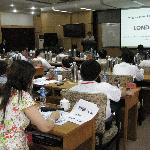Pitch
Train Mayors who are building new cities in China to incorporate climate resiliency at scale into urban planning and stakeholder management
Description
Summary
About the Climate Resilient City Design course for Chinese government leaders
In one of our flagship government training program for creating sustainable cities, JUCCCE has trained over 450 mayors, central government officials, and state owned enterprise executives through three of the eight official government training academies in China on how to build sustainable cities, Each training course reaches 40-50 members of China’s central and local government for up to three full-time in-person course days.
The Climate Resilient Cities curriculum is a new course being introduced in 2013.

Chinese mayors, unlike Western mayors, have more land use control and ability to experiment at scale with new solutions. China is building a new Chicago in new floor space a year, over the next 30 years.
This first ever course in climate resilient city design has quickly and effectively train top government leaders in China. The learnings from China's ability to quickly pilot at scale can be then used around the world to reduce loss of life, work productivity, agricultural productivity, and infrastructure.
Category of the action
Urban adaptation
What actions do you propose?
Agenda
Module 1: Climate Change Impacts and Resilience Thinking –This module tangibly defines the economic and ‘quality of life’ risks presented through climate change. Cities will have to adapt to new climactic norms, and prepare themselves for harsher, more unpredictable weather events. What can city leaders do to reduce response time and economic loss?
Leaders in charge of creating climate resilient cities need to be aware of the growing set of new adaptation measures that they need to take, whether technical or financial. Even more importantly, these leaders need to build flexibility and nimbleness into their working systems through a collaborative framework of cross-sector stakeholder engagement.
Chinese cities are uniquely able to put into place climate resilient measures at the master planning stage of city development. This is a much more cost-effective approach than retrofitting late in a city’s life.
Module 2: Types of Risk – Climate change related risk is broken down into two categories:
· The New Norms cover sea level rise, new temperature extremes and averages, and precipitation levels. These are elements that cities need a long-term adaptation plan to address as new trends emerge. Dry becomes drier, hot becomes hotter and wet becomes wetter. Cities need new building standards, technological solutions, and financial instruments to help withstand these changes.
· Extreme Events deal with wind, rain, and other storm-related events that are becoming increasingly severe and unpredictable Cities need integrated disaster planning and response systems to reduce response time and economic loss.
Module 3: Case Studies – Draw on lessons learned from successes and failures of climate resilient urban design the New Norms and Extreme Events. Case studies highlight and analyze the unique social, environmental, and political contexts in which each adaptation strategy was developed. Rather than providing ‘cure all’ technical solutions, they illustrate the important process of engaging stakeholders and collaborating across sectors, departments, industries, and scales.
These case studies also provide innovative ways that city managers around the world are adapting their city’s infrastructure and governmental organization to cope with climatic changes. They provide useful resources for city mayors to begin implementing similar responses in their municipality.
Module 4: Prepare for City Resilience – Government officials will participate in an interactive workshop and self- assessment of their locality’s risk and develop a Local Resilience Action Plan (LRAP).
Module 5: Conclusion – Key questions and next steps to bring back to student mayors’ municipalities. Provides potential private partners, contacts and resources to leverage for implementation.
We’re asking for help
To be successful we need contributions:
· Experts for video interviews
· Literature for translation
· Chinese language lecturers
· Implementation partners
Who will take these actions?
About JUCCCE
JUCCCE, a non-profit organization, accelerates the greening of China. Our work is vital to a healthier world because China's massive urbanization, industry's thirst for energy, population growth, and boom of the consumer class threaten to deplete the world's natural resources.
JUCCCE's role is to enable multi-stakeholder collaboration to catalyze systemic change in these key drivers of energy use in China- urbanization, industry, and consumption.
Although China's challenges are large, it has strong policy support. What it needs now is capability building and deployment of innovative solutions. JUCCCE serves as a technology, best practices and cultural bridge between China's key influencers and decision makers and international solution providers.
Request for Help
JUCCCE is seeking experts to help develop this course content and vendors who can offer climate resiliency solutions to cities in China. Please join JUCCCE and such contributors as Swiss Re, New York City, and Global Climate Adaptation Partners.

Where will these actions be taken?
JUCCCE creates curriculum for three of the eight official Chinese government leadership academies. These academies are in Beijing and Shanghai.

What are other key benefits?
Influencing the rapid urbanization of China over the next 20 years.
What are the proposal’s costs?
Fixed costs include curriculum development.
Variable costs cover the training time and event management needs for each training session.
Time line
The first class is aimed for September 2013, and can be repeated in Spring and Fall semesters at the academies as needed.
